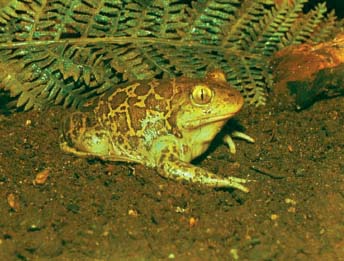Eastern spadefoot: Red Data Book of Armenia

Spadefoot toads — Pelobatidae
Status. A rare species of limited distribution and decreasing population. Listed in the Red Data Books of the former USSR and Azerbaijan. Listed in the IUCN Red List of Threatened Species (ver. 3.1) as Least Concern. According to IUCN criteria categorized as Vulnerable VU B2ab(ii, iii).
Distribution. Distributed in Syria, Palestine, Israel, Asia Minor, Balkan Peninsula and the Caucasus.
Distribution in Armenia. Lives in the south–eastern areas of the country. Very rare in the central and southern parts: Jrvezh, Arinj, Voghjaberd (Kotayk Province), Rind (Vayots Dzor Province) and Sisian (Syunik Province).
Habitats. Occurs in foothills and mountain plateaus, on rather flat terrain covered with forests, grasslands and semi–deserts.
Biological traits. Leads exclusively cryptic, nocturnal life. Reproduction lasts from late March to mid–May in permanent vegetated lakes, artificial reservoirs and wetlands. Mature individuals stay a short period in water for spawning, then go ashore. Females spawn onto submerged leaves or, if none, on the bottom. The spawn consists of 5500–6500 eggs.
Population size and its trends. In 1956, in the Vayots Dzor Province 5–6 individual spadefoots were counted per 1 km of riverside. At present, their abundance is severely reduced and in many places the spadefoot is vanished.
Major threats. Drainage and pollution of water bodies, land use for agriculture and deterioration of natural habitats.
Conservation measures. Listed in Appendix II of the Berne Convention. The sites of species presence are not protected. In 1985–1986, 1500 individuals reared in laboratory conditions were released into the Azat Reservoir (Ararat Province) where the population status was quite satisfactory. It is essential to set aside the spadefoot habitats as sanctuaries.
Suggestions
 The Ministry of Environment sent a letter international partners to draw their attention to the real danger of environmental disasters as a result of Azerbaijan's large-scale aggression towards the territory of Armenia
The Ministry of Environment sent a letter international partners to draw their attention to the real danger of environmental disasters as a result of Azerbaijan's large-scale aggression towards the territory of Armenia
 Vicia pisiformis: Red Data Book of Armenia
Vicia pisiformis: Red Data Book of Armenia
 Vavilovia formosa: Red Data Book of Armenia
Vavilovia formosa: Red Data Book of Armenia
 Trigonella capitata: Red Data Book of Armenia
Trigonella capitata: Red Data Book of Armenia
 Trigonella astroides: Red Data Book of Armenia
Trigonella astroides: Red Data Book of Armenia












